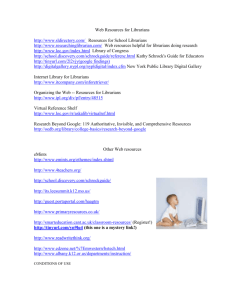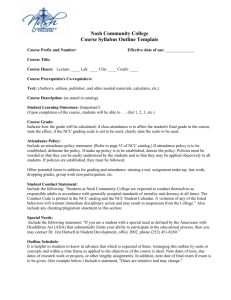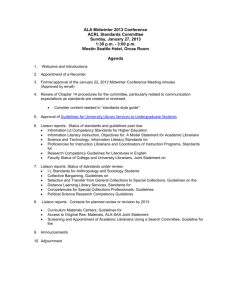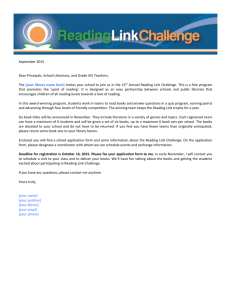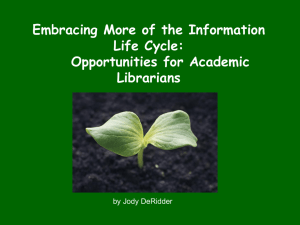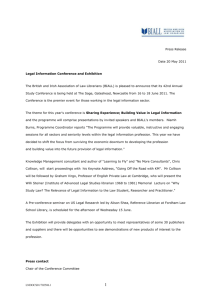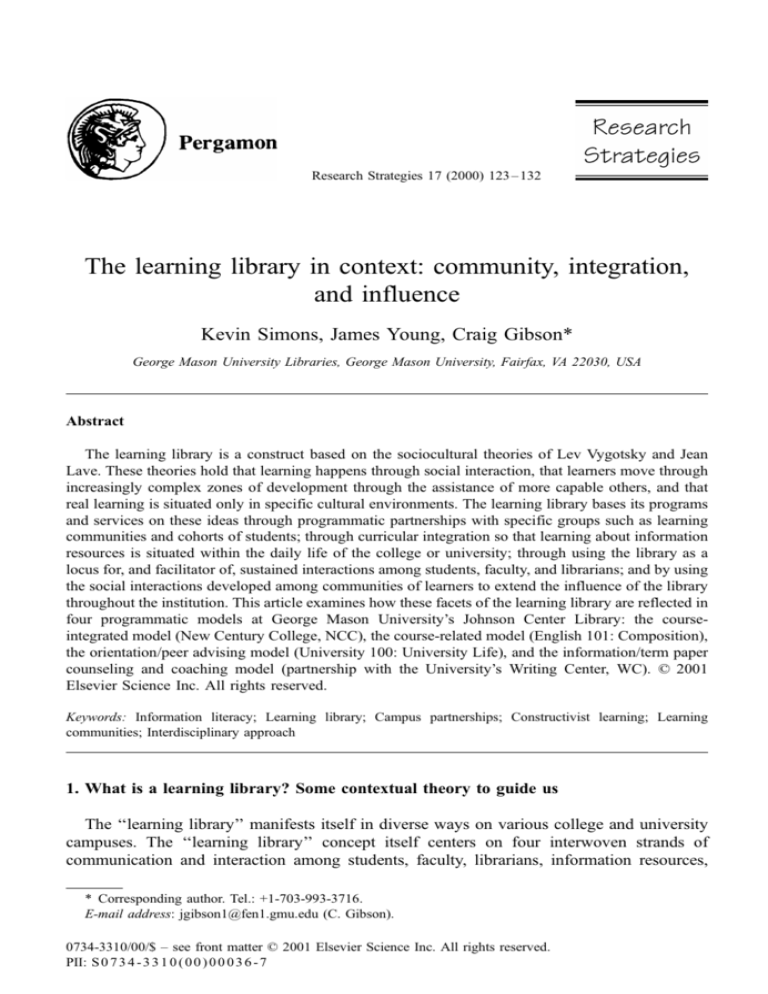
Research Strategies 17 (2000) 123 ± 132
The learning library in context: community, integration,
and influence
Kevin Simons, James Young, Craig Gibson*
George Mason University Libraries, George Mason University, Fairfax, VA 22030, USA
Abstract
The learning library is a construct based on the sociocultural theories of Lev Vygotsky and Jean
Lave. These theories hold that learning happens through social interaction, that learners move through
increasingly complex zones of development through the assistance of more capable others, and that
real learning is situated only in specific cultural environments. The learning library bases its programs
and services on these ideas through programmatic partnerships with specific groups such as learning
communities and cohorts of students; through curricular integration so that learning about information
resources is situated within the daily life of the college or university; through using the library as a
locus for, and facilitator of, sustained interactions among students, faculty, and librarians; and by using
the social interactions developed among communities of learners to extend the influence of the library
throughout the institution. This article examines how these facets of the learning library are reflected in
four programmatic models at George Mason University's Johnson Center Library: the courseintegrated model (New Century College, NCC), the course-related model (English 101: Composition),
the orientation/peer advising model (University 100: University Life), and the information/term paper
counseling and coaching model (partnership with the University's Writing Center, WC). D 2001
Elsevier Science Inc. All rights reserved.
Keywords: Information literacy; Learning library; Campus partnerships; Constructivist learning; Learning
communities; Interdisciplinary approach
1. What is a learning library? Some contextual theory to guide us
The ``learning library'' manifests itself in diverse ways on various college and university
campuses. The ``learning library'' concept itself centers on four interwoven strands of
communication and interaction among students, faculty, librarians, information resources,
* Corresponding author. Tel.: +1-703-993-3716.
E-mail address: jgibson1@fen1.gmu.edu (C. Gibson).
0734-3310/00/$ ± see front matter D 2001 Elsevier Science Inc. All rights reserved.
PII: S 0 7 3 4 - 3 3 1 0 ( 0 0 ) 0 0 0 3 6 - 7
124
K. Simons et al. / Research Strategies 17 (2000) 123±132
and curriculum: active programmatic partnerships; curricular integration; sustained interactions among students, faculty, and librarians; and extension of influence into a ``multiplier
effect.'' The central idea of the learning library is that of integration: the library becomes an
essential component of students' formal education and informal research needs. Rather than
an external ``add on'' to the educational experience, the library, as information resource and
gateway, is a primary catalyst for cognitive, behavioral, and affective changes in students Ð
as they interact with information resources as directed by faculty, as they complete assignments and study with peers, as they extend their knowledge at multiple levels, seeking
connections and making meaning in more self-directed ways. The learning library, rather than
a repository of materials or a study hall, is therefore an agency of change in students' lives.
The four strands of communication and interaction central to the learning library all
depend on social interaction. While there is certainly a place for the solitary scholar in the
learning library, newer theories of learning suggest the centrality of collaborative study, of
peer mentoring, of conversation as the vehicle for learning. Perhaps Vygotsky's constructivist
theories and the pedagogical theories of Jean Lave most clearly undergird the learning library:
the idea of novices' ``apprenticeship'' into more complex and sophisticated thinking
processes resulting from continued practice under the guidance of more capable others Ð
whether peers, faculty, or librarians. The learning library, following constructivist theory,
provides ``scaffolding'' for the novice learner and information seeker through multiple
coaching/mentoring opportunities, whether at the reference desk, in the formal instruction
room, in casual conversations in study groups, or in meetings in librarians' offices.
``Scaffolding,'' apprenticeships, and guided learning, in turn, all relate closely to Vygotsky's
concept of the zone of proximal development: the idea that learners progress from activities
that they can accomplish entirely by themselves as individuals to more complex cognitive
tasks only through the guidance and coaching of more capable others Ð more knowledgeable
adults, teachers, and peers (for the fullest exposition of Vygotsky's ideas, see Vygotsky,
1978). This sociocultural concept of Vygotsky has become central to composition theory and
other fields and has resulted in such practices as peer mentoring and reciprocal teaching. The
learning library itself is a natural manifestation of Vygotsky's ideas: students gain increasing
skill with information resources Ð both in retrieving and evaluating them Ð through
collaborating with peers on research projects, seeing how library staff model informationseeking, asking for assistance and coaching at the reference desk, and using the support
system or ``scaffolding'' provided by human- and computer-mediated assistance to become
more adept researchers and information-literate individuals. The learning library provides
supports that, in future years, will gradually be removed as students move into workplace
environments, internships, and professional positions where they may be called upon to use a
wide range of information resources independently and wisely. In the Vygotskian sense, the
learning library is the constructivist laboratory for students to make their own meanings, but
only by moving through a series of ``zones of proximal development'' with research strategies
and information sources and with the coaching and guidance of more knowledgeable others.
Closely related to Vygotsky's ideas are those of Jean Lave, who is best known for her
concepts of ``situated cognition'' and ``communities of practice.'' Basing her theories on
Vygotsky's emphasis on social interaction as the path to higher cognitive skills, Lave believes
that students gain expertise, knowledge, and skill, not through individual learning in
K. Simons et al. / Research Strategies 17 (2000) 123±132
125
classrooms in ``out-of-context,'' abstract ways, but through a process of acculturation into
communities of expertise located in real situations, not contrived, ``academic'' ones. For
Lave, much learning is tacit rather than intentional: novices become experts through
observing how the knowledgeable members of a community act and what is valued in that
community. Over time, novice learners move from the ``outside'' or periphery into the center
of the community's activities: the cultural practices of the community begin to make sense as
newcomers engage themselves more fully in the community (Lave, 1991). Lave's ideas
therefore point to other possibilities for the learning library: student cohort groups that
collaborate on research projects; learning communities from specific programs or departments
that make the library an essential component of their life, thereby creating ``communities of
practice'' with information resources; and the library as a site for apprenticeship into the
complexities of information management Ð for students, faculty, staff, and an entire campus
community. ``Situated learning'' in the learning library means creating a culture of inquiry
and investigation where the ideas of the classroom are tested in the crucible of the
contemporary information environment Ð with all of its redundancy, its conflicting claims,
and its mixture of valuable, peer-reviewed resources selected by librarians, Web-based
information resources of uncertain quality, and ``edutainment.'' Situating learning in an
arena of reasonable complexity and qualified messy reality is one way of applying Lave's
ideas to the learning library Ð the place where students become acculturated into more
sophisticated research habits, the locale for incubating ``communities of research practice''
that connect with real life: internships, service learning, the world of work, public policy
investigations, and local environmental and political campaigns. Taken together, Vygotsky
and Lave's ideas provide all the essential philosophical and educational foundation for the
daily practices of the learning library.
With such a foundation in place, certain characteristics of the learning library emerge over
time. The first component of the learning library is outreach and programmatic partnerships.
The library develops the collaborative skills necessary to ``partner'' with faculty and
administrators in developing information literacy programs and places information literacy
and the constructivist ``network of associations'' at the very heart of the teaching and learning
process. Programmatic partnerships lead to curricular integration, so that the library's
resources and instruction become essential elements of student success in identified courses
and programs. ``One-shot'' sessions taught by librarians may still have a place, but
increasingly the learning library seeks to embed information literacy in the foundations of
coursework at a programmatic level so that students have repeated, varied experiences with
information seeking. This richer curricular integration leads to, and depends upon, pervasiveness of interactions among students, faculty, and librarians related to information
resources and information literacy. Instead of the traditional limited interactions in the
instruction room and the reference desk, the learning library leverages those opportunities for
further learning in multiple ways: in Web-based instruction to elaborate upon traditional ``one
shot''; in small group discussions with students and faculty; in peer information counseling
and guidance; in office appointments with librarians; and in impromptu, ``just-in-time''
instruction with students inside or outside the library. All of this interaction, in the learning
library, creates a ``web of influence'' or a multiplier effect in which librarians become more
visible on campus, where new instructional opportunities arise, where the teaching and
126
K. Simons et al. / Research Strategies 17 (2000) 123±132
learning environment is transformed because librarians, as change agents, serve on curriculum committees, consult on program planning, work with accreditation study groups, help
design new courses, and create a campus environment in collaboration with faculty and
administrators where becoming fluent with information resources and skills is essential to
students' academic success.
The learning library depicted here may appear idealized, but many academic libraries show
some features of the idealized portrait. The range of possibilities for partnerships, curricular
integration, pervasive interactions, and the ``web of influence'' is wide indeed, and few
libraries demonstrate the totality of all of these ``learning library'' elements. The curricular
integration and creation of the network of associations central to the learning library both
manifest themselves most prominently in the curricular/programmatic models through which
the library becomes involved in the teaching and learning process. For librarians, four such
models have traditionally been known as course-integrated instruction, course-related
instruction, orientation and peer counseling, and information/term paper counseling/guidance. The degree of curricular integration obviously varies across the spectrum of these
models; but each model has its place in a total instruction program offered by the learning
library, each model may vary in its level of involvement and integration with the academic
programs and the life of the campus. In this article, we will examine several manifestations of
the learning library at George Mason University.
2. How does the learning library work at George Mason University? Looking at the
theory in practice
At George Mason University, all four curricular/programmatic models are present in the
outreach and instruction programs of the Johnson Center Library: the course-integrated
model, with extended, sustained interactions between librarians, students, and faculty, is
found most obviously in the New Century College (NCC) program; the course-related model,
with the use of a customized research guide and the beginnings of a Web tutorial, is related to
the English 101 (Basic Composition) program; the orientation/peer advising model is
manifested in the outreach program to the University 100 (Introduction to University Life)
course; and the information/term paper counseling model is apparent in the strong emerging
relationship between the library and the Writing Center (WC).
2.1. Institutional context
Some institutional background is important in understanding the unique role of the
Johnson Center Library as a ``learning library.'' George Mason University began its history
as a branch campus of the University of Virginia in 1957. In 1972, the General Assembly of
Virginia passed legislation to establish Mason as an independent university in the
Commonwealth's higher education system. Mason is a distributed university with campuses
in the cities of Fairfax (the main campus) and Arlington, and in Prince William County.
Total enrollment for Fall 1998 was 24,010, with 2110 being freshmen (George Mason
University Factbook).
K. Simons et al. / Research Strategies 17 (2000) 123±132
127
The mission of the George Mason University Libraries is to support the research needs of
the university by educating students and faculty on how to find, evaluate, and use information
of all kinds and in all formats. Following the liaison model of library service, all four libraries
have an outreach network to students and faculty in academic departments. Subject specialists
at Fenwick Library, the university's main research library, are responsible for providing
research, instructional, and collection service to the major academic departments on the
Fairfax campus. Johnson Center Librarians play a similar role by identifying programs with
large student populations and actively participating in curriculum development, student
orientation, assessment, and faculty training.
The Johnson Center Library is located within the Johnson Center, an academically focused
``campus commons'' designed to be an integrated learning environment. In addition to the
library itself, the building contains computer labs, fast-food services, a theatre, a bank, a
travel agency, a bookstore, a restaurant, and numerous academic program offices. Most
striking is the collaborative, social atmosphere: there are many study rooms, group study
tables, and other spaces for group study and discussion, with many network connections
throughout the building allowing laptop computers to be used. The building is one model of
how integrated, constructivist learning can happen through a network of interactions and
associations in one physical space. The Johnson Center Library, as one significant part of the
larger building, is one part of the ``network'' in the integrated learning environment. One of
the most prominent linkages developed by the library is that with the NCC program.
2.2. New Century College: course-integrated instruction
NCC is a learning community. A learning community can be described as ``a curricular
structure that links together several existing courses so that students have opportunities for
deeper understanding and integration of the material they are learning, and more interaction
with one another and their teachers as fellow participants in the learning enterprise''
(Gabelnick, MacGregor, Matthews, & Leigh Smith, 1990). Valuing the premise that realworld problems are interdisciplinary, NCC is less interested in the rigid disciplines and more
interested in solving the problems that connect them. The college offers ``timely'' programs
that serve to connect interdisciplinary knowledge with real-world experience and lifelong
learning skills by offering a plethora of active, hands-on learning experiences in which
information literacy plays a key role.
Organizationally, NCC is a new paradigm at George Mason University. Students fulfill
their general education requirements during an intensive first-year curriculum broken down
into four highly collaborative, team-taught, interdisciplinary 6-week courses known as
``units.'' After the first-year common curriculum, students are required to take upper level
``learning communities'' that combine subjects usually taught in separate classes into a
single course of study. Students are also responsible for applying their knowledge by
actively engaging in experiential learning activities, such as community service, overseas
study, or internships.
Another goal of the curriculum is to immerse students in the NCC competencies of
communication, critical thinking, problem solving, valuing, group interaction, global perspective, effective citizenship, aesthetic response, and information technology. In NCC,
128
K. Simons et al. / Research Strategies 17 (2000) 123±132
instead of ``learning a discipline,'' students are asked to become competent in these broad
areas that cut across subjects and are designed to be timeless and conceptual. In doing so,
students are assessed on their ability to master these overlapping areas. Instead of traditional
multiple-choice ``recall'' exams, the NCC curriculum requires students to make connections
and apply their learning in multiple contexts from multiple perspectives. This is accomplished
in many ways but mostly with intensive (and varied) research assignments, problem solving
exercises, active use of information technology, and reflective and analytical portfolios that
serve as final exams.
Throughout their experience, students closely interact with a campus-wide group of
faculty, librarians, and graduate teaching assistants. Each faculty member brings to the
classroom an expertise and unique way of knowing molded by his or her educational and
professional background. Since each unit is integrated and covers many subjects, the
emphasis is on making connections and the application of knowledge. That is, students have
access to faculty members who are simultaneously experts and generalists. Some departments
and programs from which faculty are drawn include English, Communication, Education,
Conflict Resolution, and the library.
In an effort to integrate information literacy skills into the curriculum, the NCC liaison
librarian ``leaves the library'' to team-teach in Unit I: NCLC 110, ``Community of Learners.''
In Unit I, traditional courses like English 101, Communications 101, and Computer Science
106 are integrated so students are required to focus on relevant connections. The faculty group
is responsible for creating a common syllabus, reading list, and assignments and projects for
which each student is responsible. Each individual member of the team is responsible for a
particular seminar, typically 20 students. Seminar instructors and students meet in seminar
each morning to discuss the ideas, readings, and assignments of the course. Each afternoon
students meet in a cluster-sized group to attend workshops taught by a member of the NCC
faculty team or by an expert from outside the college. Information literacy concepts are
integrated and reinforced by the seminar instructor who attends with the students. They do
this by working on active, hands-on group assignments and projects that have multiple
integration points Ð at the problem level (analytical reasoning, problem solving, and critical
thinking), at the skill level (information technology, communication, conflict resolution), and
at the content level (the particular assignment or task at hand). The description of the
yearlong, integrated project is a good way to illustrate and develop this concept.
The NCC liaison librarian's role extends beyond Unit I. Coordinating a yearlong project Ð
A Transformation Story: One of Many Ð provides additional opportunities for strengthening
the library's role in the NCC community. The Transformation Project is a cultural biography
assignment designed to link the first year general education units and serves as a vehicle for
students to develop a progression of research, writing, and technology skills. The project
incorporates the NCC competencies and integrates each unit's main themes and ideas. The
project consists of four chapters Ð one for each first-year unit Ð and a year-end analysis and
reflective piece for a yearlong portfolio. Each student chooses a person to study for the year.
In each unit, students research and write about their person in the context of the corresponding unit theme. In doing so, students are immersed in an environment in which information
literacy concepts are a natural extension of their day-to-day coursework. The NCC liaison
librarian, serving as yearlong manager of Transformation, plays a strong role in the design,
K. Simons et al. / Research Strategies 17 (2000) 123±132
129
implementation, and teaching of the project. Unlike faculty members, who rotate from unitto-unit, the librarian is ``involved'' in each unit. Because librarians help to facilitate and
provide unit-by-unit context and connection, students come to view them Ð and the library
Ð as integral to the college experience.
Further evidence of participating in collaboration and promoting community is the
libraries' relationship with the English Composition program, University 100, a course
offered to assist students with the transition to college life, and the campus WC. Each of these
programs has a particular niche to fill in the library's outreach to the campus, and each
demonstrates specific programmatic/curricular elements showing what is possible in the
learning library.
2.3. English 101 (Freshmen Composition): course-related instruction
The program at Mason with the largest student population is English 101, a required
beginning composition course enrolling approximately 1800 to 2000 students each year.
Because of the numbers of students, the libraries have historically relied on a library
workbook that serves as an orientation vehicle and an introduction to basic research concepts.
Completion of the workbook was a requirement for English 101. Students would answer
questions posed throughout the workbook and turn them in to the library for grading. Graded
answer sheets were then returned to the instructor. Because it was not associated with a
specific writing assignment, and because it was graded by someone other than the instructor,
students perceived it as busy work. Motivation to complete the workbook was low.
Over the past 2 years, the libraries have worked with the Composition program to develop
a better way to integrate library instruction into the English 101 curriculum. The nearly 70
page workbook has been reduced to a 12-page guide. The George Mason University
Libraries' Basic Guide to Research presents research concepts, emphasizing an electronic
environment. Because of the continually changing nature of information access Ð database
contracts expire and are not renewed, access software changes without warning, and Web
pages with their accompanying links change overnight Ð students need a conceptual
foundation for research. This approach fosters the underlying processes, mainly critical
thinking and problem solving, that allow them to adapt to new situations.
But any library instruction, whether a workbook, guide, or handout, has little effect if it is
not incorporated into the course. The liaison librarian to the Composition program has
become more involved in helping instructors of English 101, many of whom are adjunct,
incorporate the use of the guide into their class. The guide is most effective when the
instructor presents it to the students as a resource from the library that will help them
complete the assignment effectively. By linking the guide directly with writing assignments,
course instructors and librarians alike believe that students will see research, and the library,
as a more integral part of the writing process. Thus, the guide and the accompanying
workshop are ``course-related.'' While the guide is conceptual, the worksheet requires
students to apply the research concepts in the context of the course so that students' research
processes and writing processes become interrelated and integral to each other.
Currently under development for English 101 is a Web tutorial designed to teach the basic
research concepts explained in the guide. This tutorial will also include quizzes to assess
130
K. Simons et al. / Research Strategies 17 (2000) 123±132
students' knowledge of those basic concepts. The Web tutorial and accompanying quizzes
will become an important foundation for other components of the libraries' overall information literacy program. Longitudinal results from the quizzes should reveal gaps in student
understanding of ``the basics'' and allow further refinement in the tutorial and in opportunities
for more sustained interaction with students as they apply their developing knowledge
throughout the course in a variety of assignments, and in other courses as well.
2.4. University 100: orientation and peer advising
University 100 is an elective, for-credit course offered each year to all new students to help
them make the transition to college life and to George Mason University. The course,
enrolling approximately 600 students, offers opportunities for students to develop skills
necessary for a successful academic career. It also introduces students to the many resources
available to them from both the academic and student life arenas of college. Specific
objectives of University 100 are:
assisting with academic, social, and cultural transition to college;
developing a sense of community and school spirit;
improving interpersonal relationships and appreciation of diversity;
supporting academic and personal growth;
enhancing critical thinking skills.
Making connections is a major theme of University 100. To this end, each section is taught
by faculty and staff from many departments and offices on campus. In addition to the
instructor each section has a peer advisor who is an upper-class student selected through an
interview process. These peer advisors provide an important perspective on college life to
University 100 students. This emphasis on making connections has allowed the libraries to
become very involved in University 100, most notably with the preparation of the University
100 workbook and training of the peer advisors and instructors.
A required workbook covers each topic in the course (examples include Study Skills,
Relationships, and Leadership Development). Instructors have the flexibility to present topics
in whatever order they consider most appropriate for their class. The workbook contains
exercises, assignments, and useful resources related to each topic. Beyond a self-guided tour
of the Johnson Center Library offered in this workbook, each year the library provides a
bibliography specific to each topic chapter that includes helpful resources, print and
electronic, available in the university libraries. Because the bibliographies appear with each
chapter, the students see a ``library connection'' with each topic. Because the bibliographies
are presented as helpful resources and not as part of an unrelated assignment, the students
may be more motivated to use the library. University 100 instructors and peer advisors are
strongly encouraged to promote the use of the resources from the bibliographies throughout
the course.
The niche that an orientation program can fill in the developing positive perceptions of the
learning library is an important one. With University 100, the library is very involved in the
required preparatory classes for both the peer advisors and instructors. The University 100
K. Simons et al. / Research Strategies 17 (2000) 123±132
131
program coordinators, instructors, and peer advisors strongly believe that, for many reasons,
most incoming students are afraid to come to the library. Whether big or small, print or
electronic, libraries are confusing, often uninviting environments. Students need to feel
comfortable coming to the library and asking for help. Therefore, a major theme for the
integration of the library into the University 100 program is ``No Fear.'' Library staff
members help the peer advisors to be a resource for using the library by training them to teach
the basics of information access and conduct library tours. The goal is positive peer
interaction in developing confidence in using the library and asking for assistance.
The library is also involved in the orientation required for all University 100 instructors. As
with the peer advisors, the theme of ``No Fear'' is emphasized. Instructors are encouraged to
promote the use of the topic bibliographies and given assistance incorporating them into their
assignments, again reinforcing that the library is an integral part of the curriculum.
2.5. Writing center: term paper counseling/advising
Librarians in the Johnson Center have also progressed in developing a working relationship with the campus Writing Center. While discussing the importance of creating partnerships on campus at a university-sponsored workshop, the liaison librarian to the English
Composition program and the Director of the WC quickly saw an opportunity to showcase
both programs. Initially, jointly sponsored drop-in help sessions for both research and
writing were offered in the Johnson Center. From simple beginnings, these help sessions
have developed into a successful program that involves several staff from both the WC and
the Johnson Center Library.
A Johnson Center Library graduate research assistant (GRA) coordinates these help
sessions and is trained as a writing tutor. The library GRA now has scheduled time in the
WC to help students. The benefits of this collaboration are numerous. Scheduling the GRA in
the WC reinforces the idea that research is an integral part of the writing process. This also
gives the WC staff a resource knowledgeable in library databases and other resources. Finally,
this relationship ensures a liaison with the WC that, because the GRA position changes year
to year, provides for new and innovative ideas for enhancing the partnership. The library
GRA represents the effort to build community by integrating research and writing processes.
This is also a goal for strengthening the relationship between the libraries and English
Composition program.
3. Conclusion: the web of influence
Librarians in the Johnson Center Library have found that their very active involvement and
outreach in promoting a learning library, both within the integrated Johnson Center
environment and the larger campus setting, have created unforeseen opportunities for further
influence in the university. They have been asked to teach full-time for parts of the NCC firstyear curriculum, to assist with campus-wide assessment initiatives, to help with university
reaccredidation studies, to serve on the writing-across-the-curriculum committee for the
campus, and to become more involved in the university's technology-across-the-curriculum
132
K. Simons et al. / Research Strategies 17 (2000) 123±132
initiatives. The visibility for librarians is, of course, only an ancillary effect of the larger goal
of creating a learning library, where partnerships, curricular integration, pervasive student±
faculty±librarian interaction, and extended influence coalesce to form an integrated learning
environment. This is the library as true constructivist space, whether physical, social, or
virtual; as the place for conversation, coaching, and mentoring; as the network of associations
made possible through in-person and electronic communication; and as the web of ideas and
meanings that emerge in the minds of all who participate in it.
References
Gabelnick, F., MacGregor, J., Matthews, R. S., & Leigh Smith, B. (1990). Learning communities: creating
connections among students, faculty, and disciplines. New directions for teaching and learning no. 41
(p. 19). San Francisco: Jossey-Bass.
George Mason University Factbook. Available at: http://irr.gmu.edu/factbooks/9899/index.html.
Lave, J. (1991). Situated learning: legitimate peripheral participation. Cambridge, England: Cambridge
Univ. Press.
Vygotsky, L. S. (1978). Mind in society: the development of higher psychological processes. Cambridge, MA:
Harvard Univ. Press.


